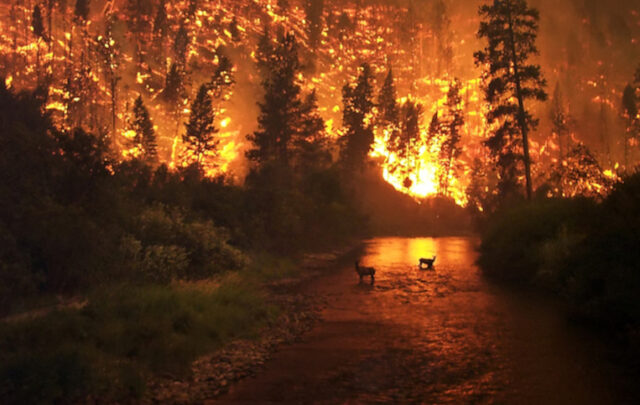Click on the headline (link) for the full text.
Many more articles are available through the Energy Bulletin homepage
As Oil Prices Soar, Prospectors Return To Pennsylvania
Neil King, Jr., Wall Street Journal
OIL CITY, Pa. — In 1859, Edwin Drake drilled the world’s first commercial oil well in this rural corner of northwestern Pennsylvania, helping kindle the petroleum age. But over time, most of the easy oil was extracted and the big companies moved on, leaving rusty oil wells and shut-down refineries in their wake.
Sky-high crude prices have now sparked what some locals see as the storied area’s last hurrah. Hoping for a final gulp of black gold, old-timers and upstarts are going after what’s left in the world’s original oil patch with drill bits, nuclear scanning machines, dynamite, chemical explosives, high-pressure water — and plain old grit. Soon they’ll even try digging it up.
… Venango County’s oily substrata has fueled and broken its share of dreams over the past 149 years. First the oil flowed by the boatload from boomtowns like Titusville and Pithole. Later the waxy stuff — Pennsylvania crude’s high wax content made it a popular engine lubricant — trickled in dribs and drabs. Mr. Drake, the first oil prospector, died broke. Refineries opened and closed. Pennzoil-Quaker State Co., once based in Oil City, moved on. Oil City and Titusville, the two county pillars, are hollowed-out versions of their former selves.
“This area has seen its share of depression,” says Randy Seitz, who runs a civic group called the Oil Region Alliance that’s trying to spur new development.
… As is the case with most tapped out oil fields, geologists estimate that around 70% of the oil that was here when Drake arrived is still locked underground. The trick is how to get it.
One Canadian company, Rock Well Petroleum Inc., thinks it’s got the solution. Having acquired the rights to 8,000 acres in the heart of Venango County, the company plans to dig several huge caverns, each more than 800-feet deep but large enough to drive a truck into. Miners will then bore and drill outward, letting the oil drain into the caverns. Pumps will bring the crude to the surface.
(18 February 2008)
Contributor Aaron Wissner writes:
Reporter Neil King Jr. wrote the January front page article on peak oil. Here, King shows how difficult it is to go back and try again for oil at the same spot. As oil prices continue to rise, we’ll see more people and small companies attempting to get at the last barrels of oil from even the oldest fields. If this isn’t an alarm bell that peak oil is upon us, I don’t know what is. Also, see King’s recent article on $100 oil prices
BA: Wall Street Journal articles that are “previews only” can sometimes be accessed by going through Google News.
US In An Energy Security ‘Mess,’ Shell Oil Exec Says
John Hofmeister, Shell Oil via Energy Policy TV
John Hofmeister, President, Shell Oil Company, describes Shell’s 50-city tour on US energy policy and discusses the need for short-, medium- and long-term US energy security.
At National Press Club.
(14 February 2008)
Bedfellows: The Prices of Gold and Oil
Peter McKenzie-Brown, Language Matters
… I recently had a discussion with an oilman just back from the Cambridge Energy Research Associates conference in Houston, where one of the speakers was Matt Simmons. Author of Twilight in the Desert, Simmons is a fierce sceptic of Saudi Arabia’s ability to increase or even maintain oil production capacity beyond the next few years. In a recent pronouncement, Simmons proposed that the world reached maximum production two years ago. The apparent increase in supply since that time has been essentially a drawdown in global inventory.
… You usually see a peak in oil prices in the spring, and the low point for oil demand is usually in December, but that is not what peak oil is about. What it is about can be seen more clearly in this simple fact: we have $90 oil, and most companies are still missing their production targets. Maybe the oil just isn’t there.
…western oil companies are now decapitalizing – buying back stock and otherwise returning cash to shareholders, rather than exploring for large new fields which aren’t there. Decapitalization is one way to acknowledge the problem of peak oil.
Whether you do or don’t believe in peak oil, there hasn’t been sufficient reinvestment in the business. There’s been a classic cycle of underinvestment. What are the major companies doing with their cash flow? Spending some of their cash on new development and buying back stock to increase shareholder value. Some major companies are replacing as little as 15% of their reserves.
This underinvestment has several causes. For one, 80% of the world’s reserves are national oil – owned by countries where aliens can’t invest directly. These countries are mostly not known for their efficient use of capital: Venezuela, Sudan, Saudi Arabia. Other known reserves and resources are located in places that are difficult and undesirable to explore, like the Arctic.
The problem has been articulated for a full century. The oilman I was talking to put it in these no-nonsense terms: “Petroleum is a capital-intensive business. You’ve got to keep offsetting depletion and there’s a massive amount of capital required just to maintain production. And suppose there’s not enough investment to both offset the decline and grow production in the near term. What’s going to happen if India and China continue to boom and expand their requirements for energy?” That is a good question.
(22 February 2008)





